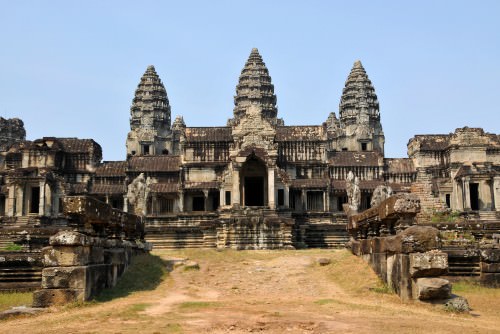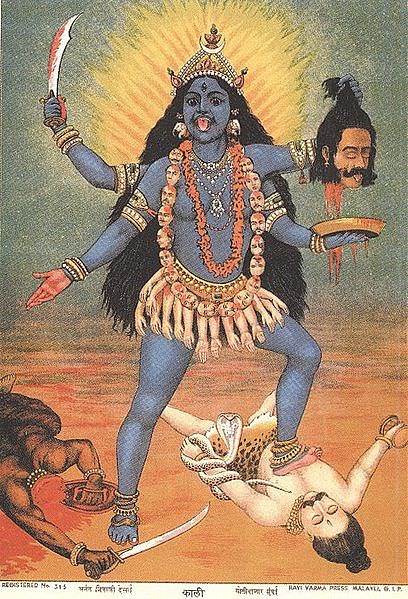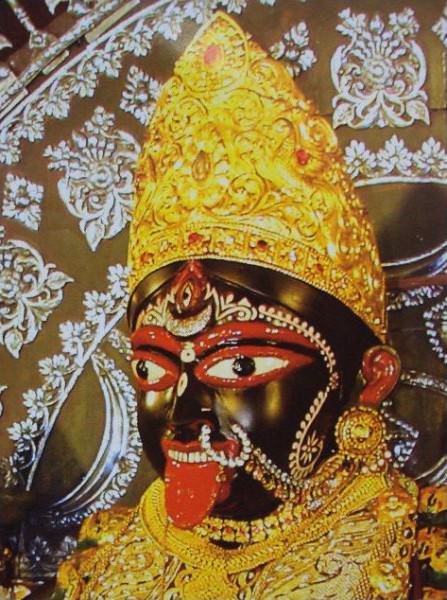Khmer Empire › Kali » Ancient origins
Articles and Definitions › Contents
- Khmer Empire › Antique Origins
- Kali › Who Was
Ancient civilizations › Historical and archaeological sites
Khmer Empire › Antique Origins
Definition and Origins

The Khmer empire was a powerful state in South East Asia, formed by people of the same name, lasting from 802 CE to 1431 CE. At its peak, the empire covered much of what today is Cambodia, Thailand, Laos, and southern Vietnam.
By the 7th century CE, Khmer people inhabited territories along the Mekong river -the world's seventh longest river - from the delta to roughly the modern Cambodia-Laos border, plus the region between that river and the great Tonle Sap lake to the west and the area running along the Tonle Sap river (which runs from the lake to the sea, joining the Mekong in the delta).There were several kingdoms at constant war against each other, with art and culture heavily influenced by India due to long established sea trade routes with that subcontinent.
Hinduism mostly, but Buddhism as well, were important religions in the region, mixed with animist and traditional cults.Important cities from that time include Angkor Borei, Sambor Prei Kuk, Banteay Prei Nokor and Wat Phu. A man called Jayavarman II, who is said to have come from a place named Java - which may or may not be the island we call Java in Southeast Asia, led a series of successful military campaigns, subjugating most of these petty kingdoms, that resulted in the founding of a large territorial state. In 802 CE he took the title chakravartin, “universal ruler”, and that date is used to signal the start of the empire.
SEVERAL TIMES THE KHMER FOUGHT WARS AGAINST TWO NEIGHBORING PEOPLES WITH POWERFUL KINGDOMS, THE CHAM AND THE VIETNAMESE.
Using the city of Angkor as capital, for the next centuries the Khmer empire expanded its territorial base, mostly to the north (entering the Khorat plateau) and the west, to the Chao Phraya basin and beyond. To the east outcomes were different: several times the Khmer fought wars against two neighboring peoples with powerful kingdoms, the Cham (in today's central Vietnam) and the Vietnamese (in today's northern Vietnam). Despite some victories, as in 1145 CE, when Cham's capital Vijaya was taken, the empire was never able to annex those lands. Conversely, Chams and Vietnamese enjoyed some victories of their own, the most spectacular of which was Cham's humiliating revenge, looting Angkor (1177 CE) and pushing the empire to the edge of destruction.
Throughout the empire's history, Khmer's court was repeatedly concerned with putting down rebellions initiated by ambitious nobles trying to achieve independence, or fighting conspiracies against the king. This was particularly true each time a king died, as successions were usually contested.
The Khmer were great builders, filling the landscape with monumental temples, huge reservoirs (called baray ) and canals, and laying an extensive road network with all sorts of bridges -the main highways are 800 km long. The most stunning temple, Angkor Wat, is a microcosm of the Hindu universe and defies imagination as the world's largest religious complex - covering 200 hectares; nowadays it is crowded with tourists amazed with ruins that until recently were covered by the jungle. Its construction took some 30 years and was started by one of the greatest kings, Suryavarman II, around 1122 CE.
The empire's greatest king was Jayavarman VII (r. 1181 CE - 1215 CE). He expelled the Chams who took Angkor, restoring the realm from anarchy, and then invaded Champa (Cham's kingdom). The scale of his construction programme was unprecedented: he built temples, monuments, highways, a hundred hospitals, and the spectacular Angkor Thom complex - a city within a city in Angkor. Jayavarman also expanded the empire's territorial control to its zenith.

Angkor Wat, Cambodia
Angkor's original name was Yashodharapura (“Glory-bearing city”), and at its apogee it was the biggest city in the world, covering an area of a thousand square kilometres, close to that of modern Los Angeles in the USA. Its population is much harder to estimate, but a figure of aproximately one million is acceptable.
The Khmer were festive people, with many celebrations all the year round. Wrestling, horse races, cock fights, fireworks, music and dances were an integral part of their culture. Most of the realm's commerce was apparently in the hands of women.The king and the elite were transported on palanquins, and used umbrellas to cover from the sun. There were several religious beliefs present, with Hinduism being favoured (yet not exclusively) by the the kings at first, and Buddhism later. The state was divided into approximately 23 provinces, with a sophisticated administration and extensive personnel going down even to the village level. Censuses were carried out periodically. Although key to the empire's prosperity, the high officers of this bureaucracy were also part of the plots that plagued the court's history.
The empire's decline and final collapse is deeply connected with the great Thai migration of the 12th-14th centuries CE. They inhabitated an area to the north of the empire, roughly where China ends and Southeast Asia begins; the Yunnan. It is a mountainous, harsh land, where a Thai kingdom called Nanchao existed. For unknown reasons, Thai populations started migrating south, in small groups at first. Thais first appear in records as as hired mercenaries for the empire, and their numbers rose as they began to establish themselves as settlers in marginal areas. The migration intensified when Mongol campaigns shook China, and when the Mongols took Yunnan in 1253 CE, further pressure for Thai migration ensued.Eventually the Thai created their own small kingdoms, the most important of them in the western side of the empire. As these kingdoms grew in power, they started to attack and annex imperial territories. The empire's economy by this time may also have been deteriorated by increased silting of the massive water works that the Khmer core area depended on. The Thai kingdom of Ayutthaya took Angkor in 1431 CE, which constitutes the end of the Khmer empire.
Kali › Who Was
Definition and Origins

Kali is the Hindu goddess (or Devi ) of death, time, and doomsday and is often associated with sexuality and violence but is also considered a strong mother-figure and symbolic of motherly-love. Kali also embodies shakti - feminine energy, creativity and fertility - and is an incarnation of Parvati, wife of the great Hindu god Shiva. She is most often represented in art as a fearful fighting figure with a necklace of heads, skirt of arms, lolling tongue, and brandishing a knife dripping with blood.
NAME & WORSHIP
Kali's name derives from the Sanskrit meaning 'she who is black' or 'she who is death', but she is also known as Chaturbhuja Kali, Chinnamastā, or Kaushika. As an embodiment of time Kali devours all things, she is irresistibly attractive to mortals and gods, and can also represent (particularly in later traditions) the benevolence of a mother goddess.
KALI'S NAME DERIVES FROM THE SANSKRIT MEANING 'SHE WHO IS BLACK' OR 'SHE WHO IS DEATH'.
The goddess is particularly worshipped in eastern and southern India and specifically in Assam, Kerala, Kashmir, Bengal, - where she is now worshipped in the yearly festival of Kali Puja held on the night of a new moon - and in the Kalighat Temple in the city of Calcutta.
KALI'S BIRTH
There are several traditions of how Kali came into existence. One version relates when the warrior goddess Durga, who had ten arms each carrying a weapon and who rode a lion or tiger in battle, fought with Mahishasura (or Mahisa), the buffalo demon. Durga became so enraged that her anger burst from her forehead in the form of Kali. Once born, the black goddess went wild and ate all the demons she came across, stringing their heads on a chain which she wore around her neck. It seemed impossible to calm Kali's bloody attacks, which now extended to any wrongdoers, and both people and gods were at a loss what to do. Fortunately, the mighty Shiva stopped Kali's destructive rampage by lying down in her path, and when the goddess realised just who she was standing on, she finally calmed down. From this story is explained Kali's association with battlegrounds and areas where cremation is carried out.
In another version of the goddess' birth, Kali appeared when Parvati shed her dark skin which then became Kali, hence one of her names is Kaushika (the Sheath), whilst Parvati is left as Gauri (the Fair One). This story emphasises Kali's blackness which is symbolic of eternal darkness and which has the potential to both destroy and create.

Kalighat Temple
In a third version, men and gods were being terrorised by Daruka who could only be killed by a woman, and Parvati was asked by the gods to deal with the troublesome demon. She responded by jumping down Shiva's throat. This was because many years previously Shiva had swallowed halahala, the poison which had risen from the churning of the ocean during the creation and which had threatened to pollute the world. By combining with the poison still held in Shiva's throat, Parvati was transformed into Kali. Leaping from Shiva's throat in her new guise, Kali swiftly despatched Daruka and all was well with the world once more.
KALI & RAKTABIJA
Finally, in yet another version of Kali's birth, there is the story of the terrible demon Raktabija (Blood-seed). This demon was, like most demons, causing a great deal of trouble with people and gods alike but even worse was his ability to produce more demons every time a drop of his blood spilt to the ground. Therefore, each time Raktabija was attacked, the only result was more demons to deal with. The gods decided to work together and combine all of their shakti or divine energy and produce one super being that could destroy Raktabija; the result was Kali (in another version only Durga produces Kali). Given all the divine weapons of the gods, Kali swiftly sought out Raktabija and his demons and proceeded to swallow them all whole so as not to spill anymore blood in the process. Raktabija himself was killed when Kali lopped off his head with a sword and then drank all of his blood, making sure none fell to the ground and thereby ensuring no more demons could menace the world.

Kali Statue
Another famous story involving Kali is her escapade with a band of thieves. The thieves wanted to make a human sacrifice to Kali, and unwisely chose a Brahmin monk as a likely victim. Dragging him to the nearest temple, the thieves prepared to make the sacrifice in front of the statue of Kali when suddenly the statue came to life. Outraged at the thieves' plan to kill a monk, the goddess took swift revenge and decapitated the whole gang, even tossing their heads about for fun, whilst naturally the Brahmin escaped to continue his life of scholarly reflection.
KALI IN HINDU ART
In art Kali is most often portrayed with blue or black skin, naked, and wearing a Bengali type crown of clay which is painted or gilded. She is, like many Hindu deities, a multiple armed figure with the number of arms being four, eight, ten, twelve, or even eighteen. Each arm usually holds an object and these can include a sword, dagger, trident, cup, drum, chakra, lotus bud, whip, noose, bell, and shield. Sometimes her left hand forms the abhaya mudra, whilst the right makes the offering varada mudra.She is often represented seated with legs crossed and having eight feet.
Kali's most common pose in paintings is in her most fearsome guise as the slayer of demons, where she stands or dances with one foot on a collapsed Shiva and holds a severed head. She wears a skirt of severed human arms, a necklace of decapitated heads, and earrings of dead children, and she often has a terrifying expression with a lolling tongue which drips blood.
LICENSE:
Article based on information obtained from these sources:with permission from the Website Ancient History Encyclopedia
Content is available under License Creative Commons: Attribution-NonCommercial-ShareAlike 3.0 Unported. CC-BY-NC-SA License